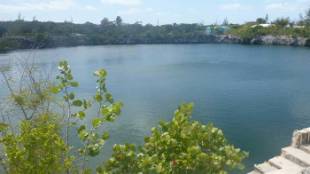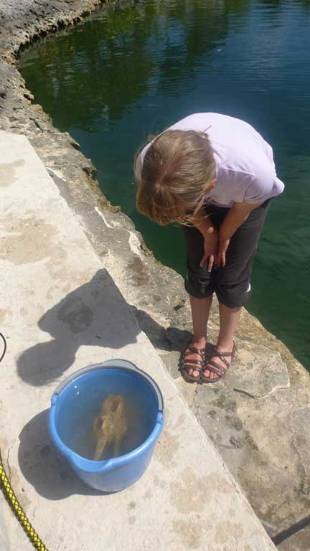Today we had an early start to begin the 200 mile round-trip to Ocean Hole on south Eleuthera.
The inland lake called Ocean Hole
(Click images to see them full size)
Ocean Hole is an inland lake, a mile from the oceans, that rises and ebbs with the tides. When we arrived we attracted a large gathering from a local school and Nick spoke to them about what we were doing with REX and why.
Above: Nick doing some educational outreach
Amongst the crowds that had gathered was Ronald Horton, who is the administrator of Ocean Hole, and I asked him his thoughts…
REX went in and immediately descended to 40m. He didn't see any mermaids but when it was looking at the rubbish littering the floor of Ocean Hole it stumbled upon a goat skull.
REX carefully brought the skull up to the surface and, although it’s not a whale bone, everyone was excited at the idea that Osedax maybe be living on the bones, albeit in the most unlikely of places. It would have definitely made up for the earlier setbacks with the sharks!
Above: Helena inspecting the goat skull
The team will now spend the best part of tomorrow trying to determine whether the worms found on the goat skull are Osedax. I’ll keep you posted!
When REX went in for a second time he descended to 38m. As he ventured down he saw this amazing purple glowing layer. From where we were sitting in the control room it looked very similar to the aurora. We nicknamed it the purple haze but what it is actually a type of bacteria.
None of the team had ever seen anything like this before. We didn't record any difference in temperature as REX descended so Adrian thinks that this purple haze may indicate the point when freshwater and sea water meet. Either way, the bacteria looked amazing on film…
Tomorrow we’re going to be analysing the goat skull under the microscope to see if we can find any evidence of Osedax. If the worm is on the goat skull it wouldn’t have been how we expected to find it, but every cloud…





